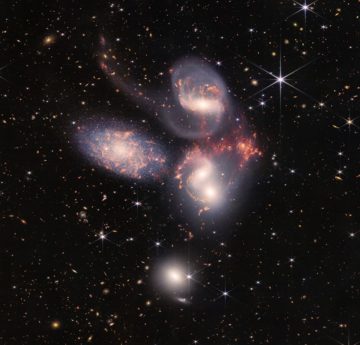Alexandra Witz in Nature:
 The views of the Universe just keep getting better. NASA’s US$10-billion James Webb Space Telescope released four new scientific images on 12 July, including newborn stars sparkling through dramatic ‘cliffs’ of gas, and galaxies interacting in an intricate cosmic dance. A day earlier, astronomers had marveled at its very first image, a mind-boggling deep dive into the distant Universe.
The views of the Universe just keep getting better. NASA’s US$10-billion James Webb Space Telescope released four new scientific images on 12 July, including newborn stars sparkling through dramatic ‘cliffs’ of gas, and galaxies interacting in an intricate cosmic dance. A day earlier, astronomers had marveled at its very first image, a mind-boggling deep dive into the distant Universe.
Webb observes the cosmos in infrared wavelengths, which gives it a different view than many other observatories, such as the Hubble Space Telescope. Webb’s 6.5-metre-wide mirror is the largest ever launched into space, and the combination of the large mirror and its infrared detection capabilities allow Webb an unprecedented view of many astronomical phenomena. That includes stars and shock waves generated as galaxies collide in the group of five known as Stephan’s Quintet, 90 million parsecs away in the constellation Pegasus. The images that Webb collected of the galaxy grouping reveal millions of young stars forming as gas and dust collide, as well as sweeping tails left by one of the galaxies, NGC 7318B, as it storms its way through the cluster. “It really shows the type of interaction that drives the evolution of galaxies,” says Giovanna Giardino, an astronomer with the European Space Agency.
More here.
